Partner and Acro Yoga: Best Poses for Two People [2025]
Partner and Acro Yoga: Best Poses for Two People [2025]

Looking for partner and acro yoga practice and couples yoga poses ? No matter if it is with a family member, your friend or your beloved one, those yoga sequences of two-person yoga poses will bring a deep stretch, physical connection, and a good laugh during your session . Those of my favorite yoga poses below will give you core strength to the lower body and a nice stretch. Don’t need the supervision of yoga teachers, you can do it yourself !
Please find below our beginner yoga poses for two people !

PLAN OF THE ARTICLE :
– Some partner yoga poses for two ( couples yoga poses )
– Two person partner yoga poses : preparation and Safety during Acro Yoga
– Easy partner yoga poses : safety During Acro Yoga
– Easy yoga poses with partner : warm-up practices before Acro yoga

Acro Yoga, a captivating fusion of acrobatics, Yoga, and therapeutic Thai massage, is a dynamic and collaborative practice that celebrates individual harmony. This partner-based discipline requires trust, communication, and a willingness to explore new physical and emotional connection dimensions.
At its core, Acro Yoga, or partner poses, integrates elements of acrobatics to create dynamic, balanced poses, Yoga for mindfulness and breath, and therapeutic techniques inspired by Thai massage for relaxation and restoration. The practice is a delightful blend of strength, flexibility, and the art of shared weight.
Partner and Acro yoga poses for two ( couples yoga poses )
You will find below some easy partner yoga poses
1. Double Downward Dog:
Both partners start in a downward dog position facing each other, creating an inverted V shape. They can walk their hands forward to deepen the stretch and engage their core muscles. Don’t forget your deep breath while practicing .

2. Partner Forward Fold:
Partners stand facing each other and hold hands. They take a step back simultaneously, hinging at the hips to create a forward fold. This pose is a great way (9.57) for hamstring flexibility.

3. Seated Twist:
Seated facing each other, partners intertwine their legs and hold hands. They then twist in opposite directions, stretching the spine and improving flexibility. Easy pose for your practice .

4. Back-to-Back Chair Pose:
Partners stand back-to-back, with their feet hip-width apart. They lower into a chair pose while supporting each other’s back. This strengthens the legs and engages the core. Great balance pose.
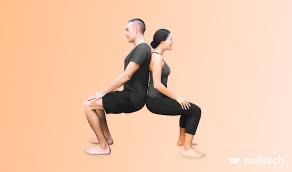
5. Double Tree Pose:
Both partners stand next to each other, each lifting one foot and placing the sole against the inner thigh of the standing leg. They can use each other for balance in this tree pose variation. Great pose for your balance .

6. Partner Boat Pose:
Sitting facing each other, partners extend their legs and hold hands. As they lean back, they lift their legs, forming a V shape. This challenges the core muscles and improves balance.

7. Partner Plank:
Partners start in a plank position facing each other. They can hold hands or simply maintain eye contact. This pose strengthens the core, arms, and shoulders.
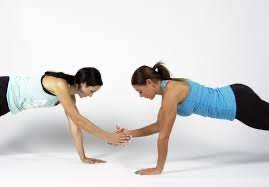
8. Double Child’s Pose:
Partners kneel facing each other, then lean forward, reaching their arms out in front. They can rest their foreheads on the ground, deepening the stretch in the back and shoulders.

9. Wheelbarrow Pose:
One partner assumes a plank position while the other holds their ankles, lifting their legs off the ground. This pose builds strength in the arms and shoulders.
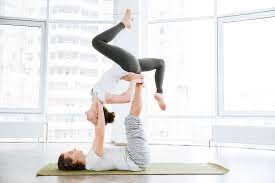
10. Partner Camel Pose:
Partners sit facing each other, knees bent and feet flat. They reach back to hold each other’s hands and simultaneously lean back, creating a backbend that opens the chest and shoulders.
These partner yoga poses not only enhance physical flexibility and strength but also foster trust, communication, and connection between individuals. Remember to communicate openly, respect each other’s comfort levels, and enjoy the shared experience of these poses.

History of Acro yoga

Acro Yoga, a vibrant fusion of acrobatics, Yoga, and therapeutic elements, has a rich history that traces its roots through various movement practices and cultural influences. Let’s explore the evolution of Acro Yoga in a series of key points:
1. Ancient Origins:
– Acro Yoga draws inspiration from traditional practices like Yoga and acrobatics that have ancient roots in different cultures.
– Yoga, originating in ancient India, contributes principles of mindfulness, breath, and body awareness.
– Acrobatics, with its roots in various cultures, including China and ancient Greece, inspires the dynamic and playful elements of Acro Yoga.
2. Circus Influence:
– The circus arts, particularly acrobatics and couple partner poses(9.74)
balancing acts, played a significant role in shaping the acrobatic side of Acro Yoga.
– Circus performers incorporated strength, flexibility, and trust-building exercises, laying the groundwork for the acrobatic feats in Acro Yoga today.
3. California Birthplace:
– Acro Yoga, as we recognize it today, emerged in California during the early 2000s.
– Jenny Sauer-Klein and Jason Nemer are credited as key founders. They blended their expertise in Yoga, acrobatics, and therapeutic arts to create a practice emphasizing trust, communication, and connection.
4. Three Main Roles:
– Acro Yoga involves three primary roles: the base, the flyer, and the spotter.
– The base provides a stable foundation, often lying on the ground or supporting the flyer with the left and right hand(10.59) and feet.
– The flyer is the person elevated off the ground, maintaining balance and engaging in various poses.
– The spotter ensures safety, offering assistance and guidance to prevent accidents.

5. Acro Yoga’s Three Elements:
– Acro Yoga integrates three main elements—Solar Acrobatic Practices, Lunar Healing Arts Practices, and Yogic Practices.
– Solar practices focus on strength, balance, and dynamic movements.
– Lunar practices involve therapeutic and restorative elements, drawing from Thai massage and other healing arts.
– Yogic practices emphasize mindfulness, breath, and the meditative aspects of traditional Yoga.
6. Global Spread:
– Acro Yoga gained popularity through workshops, festivals, and the global yoga community.
– Social media platforms played a pivotal role in spreading the joy and artistry of Acro Yoga, attracting practitioners worldwide.
7. Community and Playfulness:
– Acro Yoga is known for fostering a sense of community and playfulness.
– Jams are gatherings where practitioners come together to share and explore Acro Yoga and contribute to the collaborative and joyful spirit of the practice.
8. Evolution and Innovation:
– Acro Yoga is a dynamic practice that continues to evolve.
– Various styles and schools of thought within Acro Yoga have emerged, each bringing its unique approach and emphasis.
9. Inclusivity and Accessibility:
– Acro Yoga is celebrated for its inclusive nature, welcoming practitioners of different ages, abilities, and backgrounds.
– Workshops and classes often emphasize adaptability, allowing participants to explore and modify poses based on their comfort and skill levels.
Acro Yoga’s journey is fascinating, woven from diverse cultural threads, circus arts, and the creative collaboration of passionate individuals. It inspires communities worldwide, inviting practitioners to soar to new heights while cultivating connection, trust, and a playful spirit.

Two person partner yoga poses : preparation and Safety during Acro Yoga
Practicing Acro Yoga is a joyful and dynamic experience, but ensuring proper preparation and safety measures is crucial to enjoying the practice fully. Here’s a breakdown of points, presented in easy language:
Preparation:
1. Warm-Up:
– Always start with a thorough warm-up to prepare the body for movement.
– Increase blood flow by adding joint rotations, gentle stretches, and light cardio exercises.
2. Communication:
– Establish clear communication with your partner’s hands(8.3)
. Use simple cues and discuss any concerns or preferences before starting.
3. Partner Selection:
– Choose partners based on experience, comfort level, and trust. If you’re a beginner, practice with someone experienced or under the guidance of a certified instructor.
4. Spotter Presence:
– Have a spotter present, especially when attempting new or challenging poses.
– The spotter provides assistance and guidance and ensures safety throughout the practice.
5. Appropriate Attire:
– Wear comfortable, form-fitting clothing that allows freedom of movement.
– Remove jewelry or accessories that might cause discomfort or pose a safety risk.
Need ideas about your Yoga outfit ? Check our article HERE
6. Setting:
– Practice in a clear, open space free of obstacles.
– Ensure the surface is suitable – preferably a non-slip mat or grassy area.
7. Skill Progression:
– Progress gradually through poses, especially if you’re new to Acro Yoga.
– Master foundational poses before attempting advanced ones.
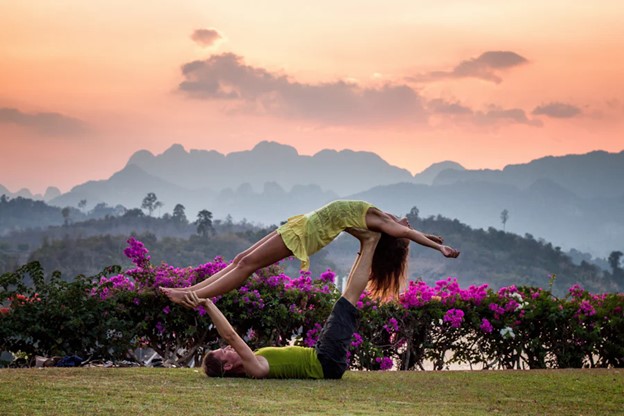
Easy partner yoga poses : safety During Acro Yoga:
8. Spotting Techniques:
– Spotters play a crucial role in ensuring safety.
– Learn and practice spotting techniques to assist the base and the flyer during poses.
9. Body Awareness:
– Develop a strong sense of body awareness. Be mindful of your movements and the movements of your partner.
10. Breath Awareness:
– Pay attention to your breath. Deep, steady breathing enhances focus, relaxation, and stability during poses.
11. Building Trust:
– Trust is at the core of Acro Yoga. Take time to build trust with your partner(s) through communication, gradually progressing from simple to more complex poses.
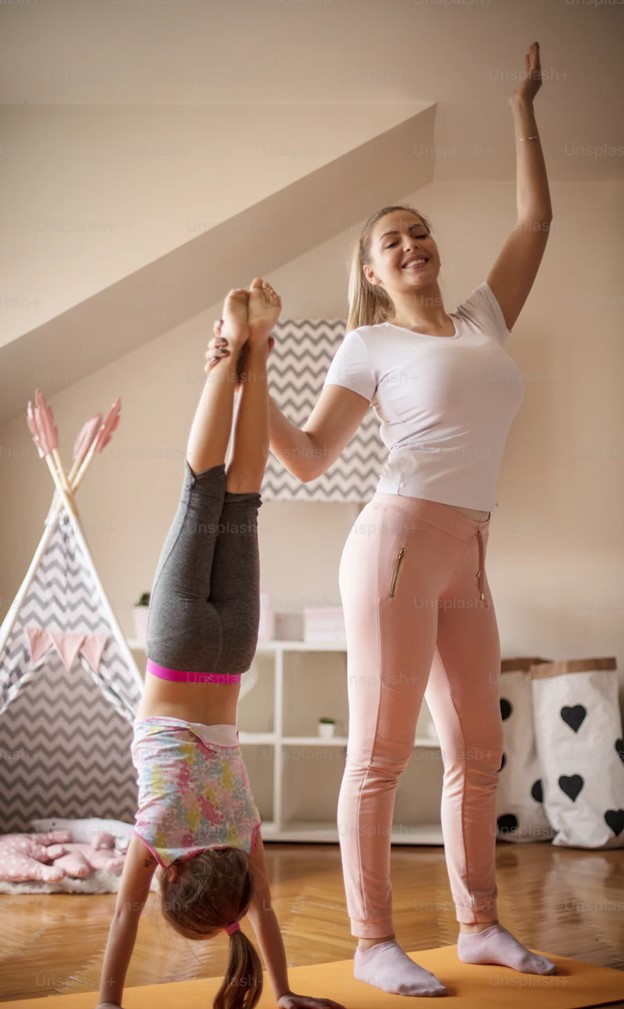
12. Limits and Boundaries:
– Communicate your limits and boundaries. Respect your partner’s boundaries as well.
– Saying “no” to a pose or asking for modifications is okay.
13. Alignment:
– Focus on proper alignment to ensure the safety of joints and muscles.
– Attend workshops or classes to learn correct techniques and alignments.
14. Spotter’s Role:
– Spotters should always be attentive, standing ready to assist and prevent falls.
– Maintain eye contact with the base and flier, anticipating necessary adjustments.
15. Relaxed Mindset:
– Cultivate a relaxed mindset. Tension or fear can affect balance and coordination.
– Use breath and mindfulness techniques to stay present and calm.
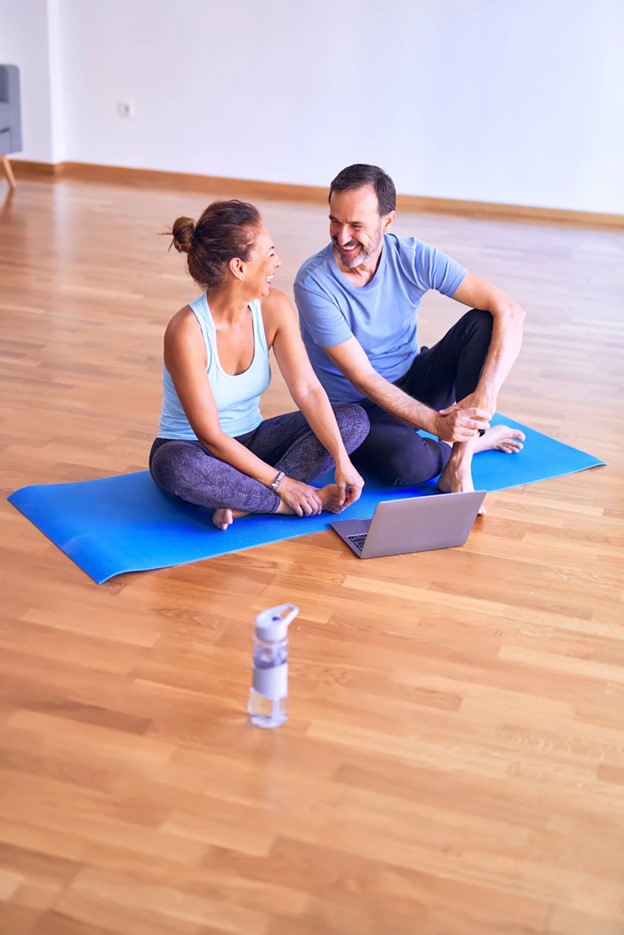
16. Rest and Recovery:
– Take breaks between poses to prevent fatigue and ensure everyone’s well-being.
– Hydrate and listen to your body’s signals for rest.
17. Emergency Plan:
– Be aware of the location of the nearest first aid kit.
– Have a basic understanding of first aid procedures for minor injuries.
18. Certified Instructors:
– If you’re new to Acro Yoga, consider taking classes from certified instructors.
– Instructors guide you through proper techniques, safety measures, and skill progression.
19. Gradual Progression:
– Avoid rushing into advanced poses. Gradual progression allows your body to adapt and build strength over time.
20. Post-Practice Reflection:
– After each session, reflect on the experience. Consider what worked well and areas that may need improvement.
– Open communication about the practice encourages a supportive and safe environment.
Remember, safety is a shared responsibility in Acro Yoga. Whether you’re the base, flyer, or spotter, each person contributes to the overall well-being of the practice. By prioritizing preparation, clear communication, and safety measures, you can fully enjoy the exhilarating journey of Acro Yoga.

Easy yoga poses with partner : warm-up practices before Acro yoga
Warm-Up Practices Before Acro Yoga:
1. Joint Rotations:
– Start with gentle joint rotations to increase mobility and flexibility.
– Rotate wrists, ankles, shoulders, hips, and neck in both directions.
2. Cardiovascular Exercise:
– Incorporate light cardio activities like jogging in place or jumping jacks to elevate your heart rate.
– This increases blood flow and warms up the entire body.
3. Dynamic Stretching:
– Perform dynamic stretches to engage muscles and improve flexibility.
– Leg swings, arm circles, and torso twists are effective for dynamic stretching.
4. Sun Salutations:
– Include a few rounds of sun salutations to integrate breath with movement.
– Sun salutations engage multiple muscle groups and enhance overall body awareness.
5. Breathing Exercises:
– Practice deep, rhythmic breathing to oxygenate your muscles and calm the nervous system.
– Belly breathing and pranayama exercises prepare the mind and body for the practice.
6. Core Activation:
– Engage the core with exercises like plank variations or boat pose.
– A strong core provides stability during Acro Yoga poses.

7. Downward Dog to Plank Transitions:
– Flow between downward dog and plank positions to warm up the upper body, shoulders, and core.
– This dynamic movement prepares the arms for weight-bearing poses.
8. Hip Opening Stretches:
– Focus on hip-opening stretches such as lunges or pigeon pose.
– Since Acro Yoga involves various leg positions, warming the hips is crucial.
9. Spinal Warm-Up:
– Incorporate gentle spinal movements like cat-cow stretches or twists.
– These movements enhance spinal flexibility and prepare for twists in Acro Yoga poses.
10. Partner Stretching:
– If practicing with a partner, incorporate assisted stretches in the opposite direction.
– Partner-assisted stretches can target specific muscle groups and enhance the sense of connection.
11. Balance Exercises:
– Include standing balance exercises like tree pose or one-legged stands.
– These exercises improve stability and focus, which is essential for Acro Yoga.
12. Wrist Mobility Exercises:
– Perform wrist circles and stretches to prevent strain on the wrists.
– Acro Yoga often involves weight-bearing on the hands, making wrist mobility crucial.
13. Neck and Shoulder Rolls:
– Loosen up the neck and shoulders with gentle rolls and stretches.
– Relieving tension in these areas is essential for a comfortable practice.

14. Playful Movement:
– Integrate playful movements like hopping, skipping, or gentle bouncing.
– This adds an element of fun and prepares the body for the dynamic nature of Acro Yoga.
15. Mindful Body Scan:
– Conclude the warm-up with a mindful body scan.
– Bring awareness to each body part, releasing tension and promoting a sense of presence.
Remember, the warm-up is an important phase that prepares your body and mind for the unique challenges of Acro Yoga. Customize your warm-up based on your needs and preferences, and always listen to your body. The goal is to create a foundation of flexibility, strength, and awareness that enhances the Acro Yoga experience.
In the world of yoga, where individual growth and self-discovery often take center stage, partner poses yoga emerges as a unique and delightful practice that shifts the focus towards connection, unity and shared experiences. This form of yoga, characterized by poses performed with a partner, goes beyond the physical benefits, weaving a tapestry of emotional, mental, and relational well-being.

Benefits of partner yoga
Partner pose yoga is a beautiful dance of bodies working together in harmony. The physical aspects of this practice promote flexibility, balance, and strength, but what makes it special is the shared effort. In poses like the Partner Tree or Double Downward Dog, individuals deepen their stretches and learn to rely on and support one another physically.
Partner pose yoga is a powerful tool for building trust. When you lean on someone for support, a bond is formed. It requires a level of trust and communication that goes beyond words. In poses like Partner Boat or Seated Twist, partners rely on each other to maintain balance and alignment.
Trust is not just about physical support; it also extends to emotional support. Trusting someone to hold you up, figuratively and literally, fosters a sense of security and openness. As partners navigate these poses together, they develop a mutual understanding and a shared sense of confidence.

Partners demand clear communication. Whether discussing the plan for the pose or adjusting each other’s alignment, effective communication is the key to a successful practice. This open dialogue cultivates a deeper connection, teaching partners to listen, express themselves, and be receptive to feedback.
Partner pose yoga has a unique way of tapping into our emotions. As individuals move through poses together, an emotional resonance arises. Poses like Partner Meditation or Heart-to-Heart Poses invite partners to connect not just physically but emotionally as well.
The shared experience of breathing in sync, feeling each other’s energy, and engaging in mutual support can be profoundly emotional. It opens a door for dynamic exploration and encourages partners to be present with one another. This emotional resonance can strengthen bonds and bring joy, laughter, or even serenity to the practice.
In partner pose yoga, every successful pose is a shared achievement. The joy of accomplishing a challenging pose together creates a sense of celebration. Whether holding a Partner Plank or attempting a Flying Warrior, partners share in the triumph, fostering a positive and encouraging atmosphere.
.

➡️ I am a Yoga teacher, meditator and wellness professional . I wrote many articles about well being, retreats, Yoga and spirituality :
– How to practice transcendental meditation
And way more ! Check it out on our website . Just type search bar 🔍 with the topic you want to explore

Wrapping up
In the canvas of yoga, partner poses paint a picture of shared journeys, trust, communication, and emotional connection. As individuals join forces on the mat, they discover that yoga is not just a solitary practice but a communal celebration of strength, balance, and unity. Partner pose yoga offers a unique lens through which practitioners can explore the art of being present, supporting each other, and creating a harmonious dance of body and soul. It is a celebration of togetherness in a world that often emphasizes individuality, a reminder that sometimes, the most profound experiences are those we share.

WHO AM I ?
Hello !
I am Eric, a French Australian citizen based between Australia, Asia and Bali and I love to travel and experience the world. I generally like outdoor activities, wellness, great food and venues , party and real local adventures ! I am a Yoga practitioner and fitness lover
I created this blog because I love to travel and I want to share my experiences with others. I’ve been traveling since I was a child, and I’ve been to over 50 countries. I’ve seen some amazing things and met some amazing people, and I want to help others experience the same things.
I believe that travel is one of the best ways to learn about the world and about yourself. When you travel, you’re forced to step outside of your comfort zone and experience new things. You learn about different cultures, different religions, and different ways of life. You also learn about yourself, your strengths, and your weaknesses.
Travel can also be a great way to make new friends. When you’re traveling, you’re surrounded by people from all over the world, and you’re all in the same boat. You’re all there to explore and experience new things, and that can create a bond between people.
Let’s connect together !
I hope that my travel blog will inspire others to travel and to see the world. I also hope that it will help people to learn about different cultures and to become more open-minded.


![What Is Hot Yoga (Bikram Yoga Def): Tips, Benefits [2025]](https://funkyfreshtravels.com/wp-content/uploads/2024/05/Picture1-28.jpg)



